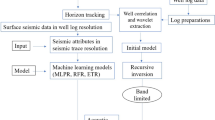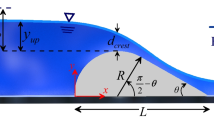Abstract
Knowledge of the deformation properties of the rock mass is essential for the stress–strain analysis of structures such as dams, tunnels, slopes, and other underground structures and the most important parameter of the deformability of the rock mass is the deformation modulus. This paper describes statistical models based on multiple linear regression and artificial neural networks. The models are developed using the test results of the deformation modulus obtained during the construction of the Iron Gate 1 dam on the Danube River and correlate these with measurements of the velocities of longitudinal waves and pressures in the rock mass. The parameters used for defining the models were obtained by in situ testing during dam construction, meaning that scale effects were also taken into account. For the analysis, 47 experimental results from in situ testing of the rock mass were obtained; 38 of these were used for modelling and nine were used for testing of the models. The model based on the artificial neural networks showed better performance in comparison to the model based on multiple linear regression.












Similar content being viewed by others
References
Ajalloeian R, Mohammadi M (2014) Estimation of limestone rock mass deformation modulus using empirical equations. Bull Eng Geol Environ 73:541–550. doi:10.1007/s10064-013-0530-3
Aksoy CO, Geniş M, Aldaş GU, Özacar V, Özer SC, Yilmaz Ö (2012) A comparative study of the determination of rock mass deformation modulus by using different empirical approaches. Eng Geol 131–132:19–28. doi:10.1016/j.enggeo.2012.01.009
Alemdag S, Gurocak Z, Cevik A, Cabalar AF, Gokceoglu C (2015a) Modelling deformation modulus of a stratified sedimentary rock mass using neural network, fuzzy inference and genetic programming. Eng Geol 203:70–82. doi:10.1016/j.enggeo.2015.12.002
Alemdag S, Gurocak Z, Gokceoglu C (2015b) A simple regression based approach to estimate deformation modulus of rock masses. J Afr Earth Sci 110:75–80
Azimian A, Ajalloeian R (2014) Empirical correlation of physical and mechanical properties of marly rocks with P wave velocity. Arab J Geosci 8:2069–2079. doi:10.1007/s12517-013-1235-4
Banimahd M, Yasrobi S, Woodward P (2005) Artificial neural network for stress-strain behavior of sandy soils: knowledge based verification. Comput Geotech 32:377–386
Bieniawski ZT (1978) Determining rock mass deformability: experience from case histories. Int J Rock Mech Min Sci Geomech Abstr 15:237–247
Brotons V, Tomás R, Ivorra S, Crediaga A (2014) Relationship between static and dynamic elastic modulus of calcarenite heated at different temperatures: the San Julián’s stone. Bull Eng Geol Environ 73:791–799. doi:10.1007/s10064-014-0583-y
Chun BS, Ryu WR, Sagong M, Do JN (2009) Indirect estimation of the rock deformation modulus based on polynomial and multiple regression analyses of the RMR system. Int J Rock Mech Min Sci 46:649–658. doi:10.1016/j.ijrmms.2008.10.001
Gokceoglu C, Sonmez H, Kayabasi A (2003) Predicting the deformation moduli of rock masses. Int J Rock Mech Min Sci 40:701–710. doi:10.1016/S1365-1609(03)00062-5
Hagan M, Menhaj M (1994) Training feedforward networks with the Marquardt algorithm. IEEE Trans Neural Netw 5:989–993
Hoek E, Brown E (1997) Practical estimation of rock mass strength. Int J Rock Mech Min Sci 34:1165–1186
Hoek E, Diederichs MS (2006) Empirical estimation of rock mass modulus. Int J Rock Mech Min Sci 43:203–215. doi:10.1016/j.ijrmms.2005.06.005
Kayabasi A, Gokceoglu C, Ercanoglu M (2003) Estimating the deformation modulus of rock masses: a comparative study. Int J Rock Mech Min Sci 40:55–63. doi:10.1016/S1365-1609(02)00112-0
Khandelwal M (2013) Correlating P-wave velocity with the physico-mechanical properties of different rocks. Pure Appl Geophys 170:507–514. doi:10.1007/s00024-012-0556-7
Kujundzic B (1970) Contribution of Yugoslav experts to the development of rock mechanics. In: Proceedings of the second congress of the international society for rock mechanics, pp 169–174
Kujundzic B (1977) Basics of rock mechanics I. Society of Civil Engineers and Technicians of Yugoslavia, Belgrade
Kujundzic B, Grujic N (1966) Correlation between static and dynamic investigations of rock mass in situ. In: Proceedings of the first congress of the international society of rock mechanics, pp 565–571
Majdi A, Beiki M (2010) Evolving neural network using a genetic algorithm for predicting the deformation modulus of rock masses. Int J Rock Mech Min Sci 47:246–253
Monjezi M, Dehghani H (2008) Evaluation of effect of blasting pattern parameters on back break using neural networks. Int J Rock Mech Min Sci 45:1446–1453
Nejati HR, Ghazvinian A, Moosavi SA, Sarfarazi V (2014) On the use of the RMR system for estimation of rock mass deformation modulus. Bull Eng Geol Environ 73:531–540. doi:10.1007/s10064-013-0522-3
Nicholson G, Bieniawski Z (1990) A nonlinear deformation modulus based on rock mass classification. Int J Min Geol Eng 8:181–202. doi:10.1007/BF01554041
Osborne M (1992) Fisher’s method of scoring. Int Stat Rev 60:99–117
Pappalardo G (2015) Correlation between P-wave velocity and physical—mechanical properties of intensely jointed dolostones, Peloritani Mounts, NE Sicily. Rock Mech Rock Eng 48:1711–1721. doi:10.1007/s00603-014-0607-8
Pinto da Cunha A, Muralha J (1990) About LNEC experience on scale effects in the deformability of rock masses. In: proceedings of the first international workshop on scale effects in rock masses, Loen, Norway
Rumelhart D, Hinton G, Williams R (1986) Learning representations by back-propagating errors. Nature 323:533–536
Serafim JL, Pereira JP (1983) Considerations on the geomechanical classification of Bienawski. In: Proceedings of the symposium on engineering geology and underground openings 1133–1144
Shen J, Karakus M, Xu C (2012) A comparative study for empirical equations in estimating deformation modulus of rock masses. Tunn Undergr Space Technol 32:245–250
Shen X, Chen M, Lu W, Li L (2016) Using P wave modulus to estimate the mechanical parameters of rock mass. Bull Eng Geol Environ. doi:10.1007/s10064-016-0932-0
Song YH, Ju GH, Sun M (2011) Relationship between wave velocity and deformation modulus of rock masses. Rock soil Mech 32(5):1507–1512 (in Chinese)
Sonmez H, Gokceoglu C, Nefeslioglu HA, Kayabasi A (2006) Estimation of rock modulus: for intact rocks with an artificial neural network and for rock masses with a new empirical equation. Int J Rock Mech Min Sci 43:224–235
Wittke W (2014) Rock mechanics based on an anisotropic jointed rock model (AJRM). Ernst & Sohn, Berlin
Yu H, Wilamowski BM (2011) Levenberg–Marquardt training. Ind. Electron. Handbook, vol. 5—IEE Inteligent Systems 12–1 to 12–16. CRC Press 2011, London. doi:10.1201/b10604-15
Acknowledgements
The part of this research is supported by Ministry of Education and Science of Serbia, Project TR37013 (Development of a system for safety management of high dams in the Republic of Serbia).
Author information
Authors and Affiliations
Corresponding author
Rights and permissions
About this article
Cite this article
Radovanović, S., Ranković, V., Anđelković, V. et al. Development of new models for the estimation of deformation moduli in rock masses based on in situ measurements. Bull Eng Geol Environ 77, 1191–1202 (2018). https://doi.org/10.1007/s10064-017-1027-2
Received:
Accepted:
Published:
Issue Date:
DOI: https://doi.org/10.1007/s10064-017-1027-2




